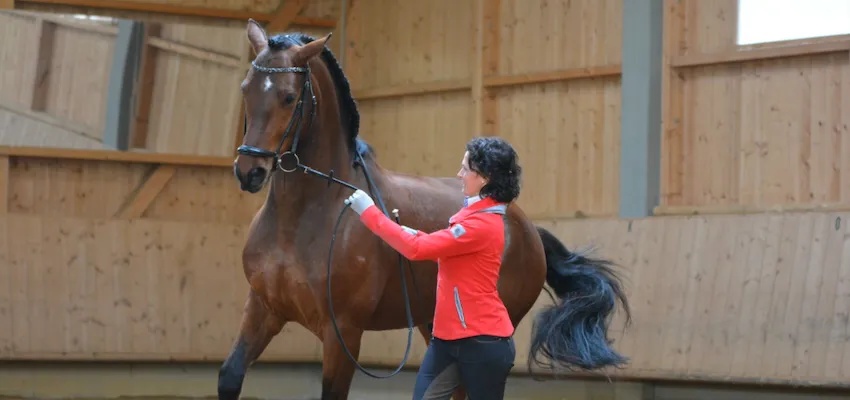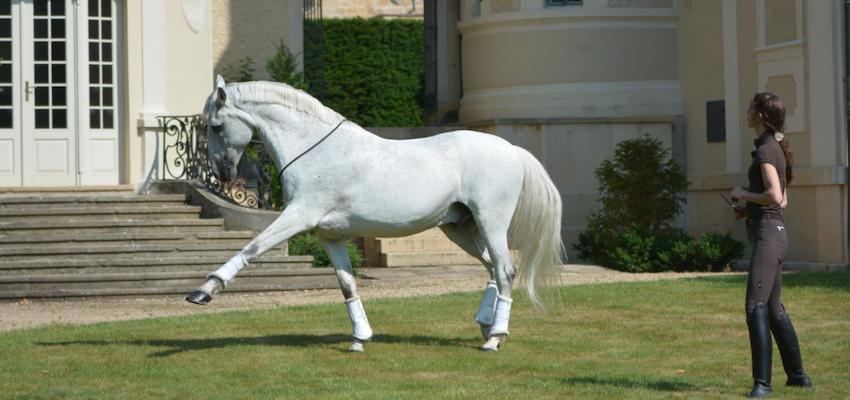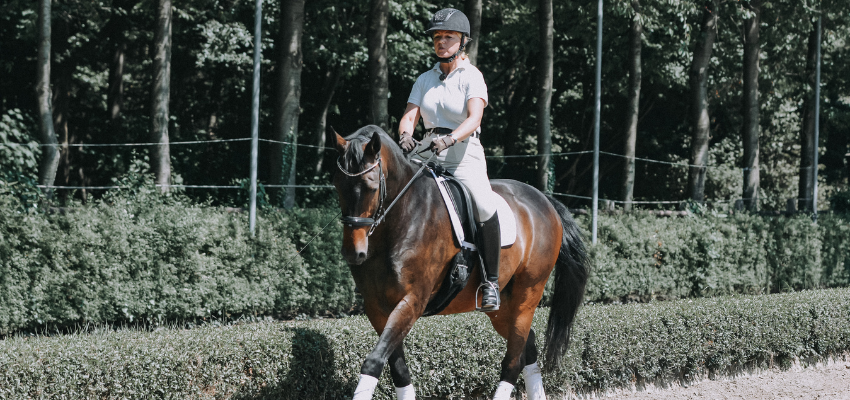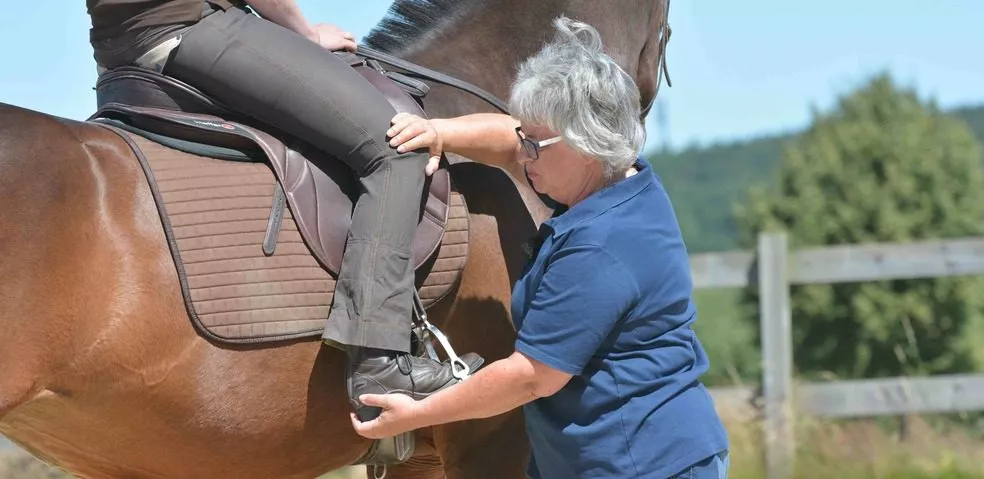Groundwork is the foundation for building a trusting and reliable relationship with your horse. It improves the communication between a horse and his human and is also a very good alternate program to riding and lunging. This article gives you a guideline on how to get started with groundwork and shows you what liberty training and the much praised clicker training is all about.
The Equipment
Before we can start to work with our horse from the ground, we need to make sure we have the right equipment and know from where to start with the basic groundwork. The rule “safety first” applies, so we need to start working in an enclosed arena or a round pen. We need a halter, a leading rope and a long dressage crop. And in case we are dealing with an easily spooked or clumsy horse, it is a good idea to put on some leg protection, like bell boots and splint boots.
Basic Ground Aids
The basic aids that are our means for communicating with our horse are our voice, our body language and artificial aids, like the dressage crop or the clicker. And of course, a bag of treats for our horse comes in handy, so this counts as an aid as well. Groundwork is all about setting a frame of rules in which the horse can move and try things out for himself. The most important rule is: The Horse and the human have their own individual space that is to be respected.
The first step and goal is to teach the horse that he should walk next to us: Shoulder to shoulder. We can’t uphold the communication when the horse storms off or trails far behind us. And this is the part that requires a lot of patience and also consistency from us in order to help the horse understand what is asked from him. So if the horse walks in front of us, we have to stop him by stiffening our body posture, using a calming voice aid and raising the crop slightly in front of him to create a visual barrier. We shouldn’t use the rope to stop the horse! It’s a good idea to take the rope only between the index finger and thumb in order to prevent us from automatically pulling on the rope. If the horse goes behind our shoulder, we have to make him stop too and then send him forwards with the help of the crop and our forward-driving body posture. Tongue clicking often helps too. Training the horse to walk shoulder to shoulder can go on for a long time until the proper walk has settled in.
As soon, as this works out fine, it is a good idea to practice transitions from walk to halt and from halt to walk from the ground. This makes the horse attentive to our aids and we can try to refine them, testing if the horse still listens to our aids. And remember: If the horse does something right, we immediately praise him and give him a well-deserved treat. It’s all about that positive reinforcement!
The next step is to turn around the horse. It’s important that we always turn around our horse while standing outside from the horse and not on its inside. The right way to turn the horse is by stopping him, turning in our own shoulder and going into the new direction. The crop can help the horse and lead the way.

The Benefits of Groundwork and Liberty Training
Groundwork and liberty training help to build a very strong relationship between the horse and its human but it also has even more benefits. If the horse has already learned advanced exercises like the spanish walk for example or lateral movements, the horse gets a better feeling for its own body and becomes more agile and fit. So groundwork is also a great addition to gymnasticing the horse, especially if the rider is not experienced enough yet to teach the horse advanced exercises from the saddle. Being able to perform exercises where the horse becomes “big” (for example a piaffe) gives a huge confidence boost and therefore is very well suited for insecure horses that are submissive in the herd.
Another huge advantage of groundwork is the opportunity to master agility courses together. These courses are full of fun obstacles that train the horse’s balance and surefootedness. And these are traits that always come in handy. It is also a lot of fun for humans and horses to eventually be able to let off steam together in liberty and without having to be dependent on any equipment or an enclosed environment.
Exercises for Groundwork
The following exercises are the next step after having established the basic aids and rules from the chapter “Basic Ground Aids”. So the requirements of being able to stop and turn your horse around must be met first.
The first exercise is to make our horse step back. Before giving the backwards aids- which are raising the crop before the horse, turning our shoulder slightly back and stepping back- the horse has to stand still for a moment without getting impatient or moving without having been asked to. If the horse should stop stepping backwards, we bring the crop to his hindlegs to drive him forwards.
The next exercise is the change of direction in a small circle around us. We make the horse step around us, then invite him to come closer and to step inside the small circle. After the horse has stepped into the circle, we create a barrier with the crop and change our body posture to drive the horse back onto the circle but this time on the new hand. It’s a good idea to repeat these changes of direction a few times. Not only to establish this new exercise but also to make the horse supple in it’s body since he has to yield and bend in both directions.
The last exercise this chapter presents, is crossing the hindlegs on a circle. It’s the first exercise that introduces the horse to mobilizing lateral movements from the ground and is the basis for future leg yielding and shoulder-in. In this exercise, we let the horse step around us while the crop aims at- or touches- the horse’s hindlegs rhythmically and thus drives the horse sideways. Meanwhile we keep the horse’s shoulders on track by keeping the horse’s head in the middle and flex it slightly to the other side. In the beginning, we execute this exercise at a slow pace, so the horse has the chance to sort out his legs in peace. And of course we should do this exercise on both hands to keep the strain even.
Exercises for Liberty Training
Liberty training is- as the word already implies- a training with exercises, the horse performs without any halter or rope and also often in liberty and not in an enclosed arena. Typical exercises are lying down, sitting down, rising, the compliment but also exercises, we know from dressage, like piaffe, passage, pirouette and the levade.
The aids in liberty training consist only of the voice, the body posture and sometimes a crop. Performing advanced exercises like cantering together with the horse from the ground, takes many years to learn. But any horse can learn it and the basics aren’t that difficult. First, the horse has to understand the groundwork basics which are: Walking shoulder to shoulder, stepping backwards and forwards, changing directions and stepping sideways. As soon as this works well, the halter can be removed. A milestone is achieved, when it’s possible to lead the horse in a circle and to do transitions from walk to halt, without the halter and by just using the body language and the voice aids.
There are many trainers and experts in this field who work with different methods and approaches. Some trainers don’t give treats, some work with pressure and then there are some who work with the relatively new clicker training.

Clicker Training
The clicker training is a method to simplify working with horses from the ground by using the signal of the “click click”- sound, the clicker generates. The horse learns to react to the clicker because he has learnt beforehand that he can expect a treat when the sound of the click appears. So this method works with positive reinforcement and everytime the horse does something right, he hears the click sound. So he learns after a time which reaction is expected from him. It is possible to guide a horse without any kind of equipment through an agility course by just using the clicker.
In the beginning, the most important factors to consider are: The right timing which consists of: giving the horse his treats at a very fast pace and the right rhythm of the clicking (it’s ought to be a very fast “click click”). And another factor is keeping the distance and maintaining one’s personal space by making sure to feed the horse with an arm's length distance. Since the foundation of clicker training is politeness, it’s important that the horse respects the individual space of its human and doesn’t intrude by taking matters into its own hands (or hooves) and asking for treats or looking where they might come from.

Groundwork sets the foundation for a trusting and reliable relationship between horse and human. It also allows us to vary our training program and include many new exercises and tricks that are fun and at the same time very useful to train the horse’s agility and flexibility. The liberty training is the culmination of a good groundwork and results from a refined and trusting communication.
If groundwork and liberty training could be something, you and your horse might like, then check out our website and get started!




